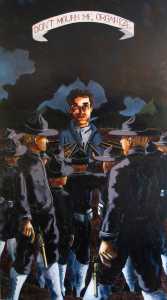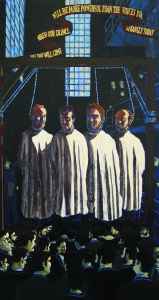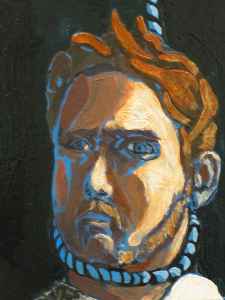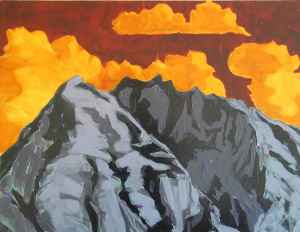Leo Muellner
USA (United States)
Kunstart: Malerei
Technik: Ölmalerei
Stil: Gegenständlich
Statement:
I am a painter of history, politics, and memory. While rooted in the tradition of the epic narrative, my work is more historigraphic than historical. There is still a tragic story to be told, but it is far more important to convey the place these dramas hold in our current imaginations. While Ilya Repin or Eugene Delacroix sought to part the waters of time to reveal the event as it happened--"here’s how Saint Nicholas saved the condemned!"--"It was just so when the crusaders entered Constantinople!"--I seek to capture the very distortions and refractions that decades of war, revolution, repression, hope, cynicism and commoditization have piled upon the distant acts.
My current paintings examine the phenomena of Left wing romanticism and the left-as-religion. The work takes the form of a hagiography divided into two series on the martyrs and heroes of the turn-of-the-century American Left.
In its lighting and scale, the first series seeks to do for American radicalism what Caravaggio did for Christianity–create riveting iconic images glorifying the sacrifices of the founding martyrs. In so doing, I hope to fill in a gap in the American left’s religious credentials––adding a catalogue of paintings to the liturgy and catechism, taboos, high priests and vestments which already give leftism the trappings of religious faith.
The second series abandons the conventions of Christian martyrdom scenes and heads in the direction of comic book or t-shirt art. This is in part a nationalist response to the Che Guevara craze: why wear an Argentinean Maoist on your chest when you could sport an American radical like Big Bill Haywood or Eugene Debs? Beyond a patriotic calling for American leftists to abandon their fascination with hip foreigners and return to their roots, these works also address the recent commoditization of leftism which has succeeded the earlier 20th century sanctification.
Both series, however, go beyond mere propagandizing. Though they start out in the realm of tribute, the works stray into a mournful mockery. The bold words emblazoned across each painting may yet strike an inspirational chord, but the marginalization of the American Left and the withering of the labor movement make it far more likely that such statements will read as the touching absurdities of a far-gone era. In the end, this hagiography of the American Left—in its religious and mass cultural depictions—begs the question: do such romantic images promote the cause, or do they make it easier for people to adopt a vague cultural leftism in place of meaningful political action?
Vita / Lebenslauf:
I am a painter of history, politics, and memory. While rooted in the tradition of the epic narrative, my work is more historigraphic than historical. There is still a tragic story to be told, but it is far more important to convey the place these dramas hold in our current imaginations. While Ilya Repin or Eugene Delacroix sought to part the waters of time to reveal the event as it happened--"here’s how Saint Nicholas saved the condemned!"--"It was just so when the crusaders entered Constantinople!"--I seek to capture the very distortions and refractions that decades of war, revolution, repression, hope, cynicism and commoditization have piled upon the distant acts.
My current paintings examine the phenomena of Left wing romanticism and the left-as-religion. The work takes the form of a hagiography divided into two series on the martyrs and heroes of the turn-of-the-century American Left.
In its lighting and scale, the first series seeks to do for American radicalism what Caravaggio did for Christianity–create riveting iconic images glorifying the sacrifices of the founding martyrs. In so doing, I hope to fill in a gap in the American left’s religious credentials––adding a catalogue of paintings to the liturgy and catechism, taboos, high priests and vestments which already give leftism the trappings of religious faith.
The second series abandons the conventions of Christian martyrdom scenes and heads in the direction of comic book or t-shirt art. This is in part a nationalist response to the Che Guevara craze: why wear an Argentinean Maoist on your chest when you could sport an American radical like Big Bill Haywood or Eugene Debs? Beyond a patriotic calling for American leftists to abandon their fascination with hip foreigners and return to their roots, these works also address the recent commoditization of leftism which has succeeded the earlier 20th century sanctification.
Both series, however, go beyond mere propagandizing. Though they start out in the realm of tribute, the works stray into a mournful mockery. The bold words emblazoned across each painting may yet strike an inspirational chord, but the marginalization of the American Left and the withering of the labor movement make it far more likely that such statements will read as the touching absurdities of a far-gone era. In the end, this hagiography of the American Left—in its religious and mass cultural depictions—begs the question: do such romantic images promote the cause, or do they make it easier for people to adopt a vague cultural leftism in place of meaningful political action?
Aktivitäten / Ausstellungen:
|
|

|
The Martyrdom of Joe Hill
Malerei
Ölmalerei
180 x 100 cm
2003
verkäuflich (Preis auf Anfrage)
mehr Informationen
|

|
The Haymarket Martyrs
Malerei
Ölmalerei
126 x 67 cm
2006
verkäuflich (Preis auf Anfrage)
mehr Informationen
|

|
Detail From The Haymarket Martyrs
Malerei
Ölmalerei
127 x 66 cm
2006
verkäuflich (Preis auf Anfrage)
mehr Informationen
|

|
Mount Katahdin
Malerei
Acryl
67 x 86 cm
2006
verkäuflich (Preis auf Anfrage)
mehr Informationen
|
|





